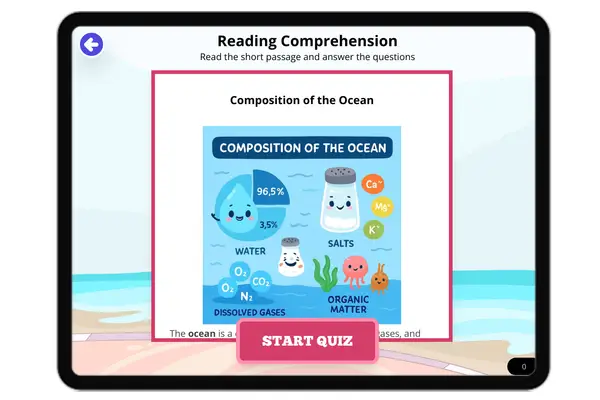Surface Ocean Currents — Passage

Surface ocean currents are movements of water in the upper 400 meters (1,300 feet) of the ocean. They are primarily driven by wind and influenced by the Earth’s rotation and the shape of ocean basins.
Surface currents follow predictable patterns called gyres, which are large circular loops of water. In the Northern Hemisphere, gyres rotate clockwise, while in the Southern Hemisphere, they rotate counterclockwise. These currents transport warm water from the equator toward the poles and cold water from the poles toward the equator.
One of the most well-known surface currents is the Gulf Stream, which carries warm water from the Gulf of Mexico to the North Atlantic. This current significantly affects the climate of Western Europe, making it milder than other regions at similar latitudes.
Surface currents also play a role in marine ecosystems by transporting nutrients and plankton. For example, the California Current brings cold, nutrient-rich water to the surface, supporting abundant marine life along the west coast of the United States.
Fun fact: The Kuroshio Current in the Pacific Ocean is one of the strongest surface currents, flowing at speeds of up to 4 meters per second (9 mph)!
What are surface ocean currents?
Movements of water in the deep oceanMovements of water in the upper 400 meters of the oceanThe formation of wavesThe melting of iceWhat drives surface ocean currents?
Temperature and salinityWindEarth’s rotationUpwellingWhat are gyres?
Large circular loops of waterDeep ocean currentsTypes of wavesUnderwater mountainsWhat is the Gulf Stream?
A deep ocean currentA surface current that carries warm water to the North AtlanticA type of upwellingA process that forms icebergsWhat is one effect of the Gulf Stream on Western Europe?
It makes the climate colderIt makes the climate milderIt reduces rainfallIt increases temperature variationsWhat is one role of surface currents in marine ecosystems?
They reduce nutrient availabilityThey transport nutrients and planktonThey stop ocean circulationThey increase salinityWhat is the fun fact mentioned in the passage?
The Kuroshio Current flows at speeds of up to 4 meters per secondSurface currents have no effect on climateGyres rotate counterclockwise in the Northern HemisphereThe Gulf Stream is a deep ocean currentWhat is the California Current known for?
Bringing warm water to the surfaceBringing cold, nutrient-rich water to the surfaceStopping plankton growthIncreasing salinity



















